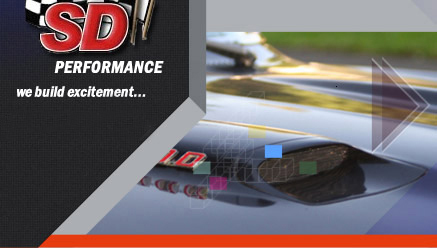|
What You Should Know About CNC Head Porting
June 2, 2008
5 Axis CNC head porting has been around for about 25 years now but up until the last 5-10 years it was primarily used by high end race engine builders because the time involved for the creation of the tool paths and the equipment costs made the process very expensive. In the last 5 years lower priced equipment (less than $250,000) has come on the market along with more efficient computer programs and higher powered computers to allow smaller cylinder head porting shops to step up to the next level by moving into automated head porting on 5 axis CNC machines. In Sept. 2006 SD Performance made this step.
There are a number of systems out there which use various methods of mounting and rotating the head to allow the cutter to remove material. When looking at systems one of the key concerns is the transition of the Bowl program (cutter is entering the port from the valve seat side of the port) and how it mates to the Port program (cutter is entering the port for the intake manifold or exhaust manifold/header side of the port). Little or no step in the transition of the two programs is a key to a well duplicated and correct flowing port. Some equipment is worse then others primarily because of backlash issues with the rotary tables being used to tilt the head back and forth or the cutter head back and forth. This backlash causes the mating of the two programs to be worse which will reduce airflow when compared to the sample used to create the program.
In our shop we typically find that the CNC ported port will flow as good or better then the hand ported sample which we digitized to create the tool paths. How's that possible you may be asking? A few factors come into play, with experience I've been able to clean up areas in the port in the CAD/CAM software to create a better smoother surface, also the CNC cutter only removes material where it is needed not everywhere just to make the port look pretty and lastly our equipment doesn't have the backlash issues some of the other machines out there have since the Patented Centroid tilt table uses a ball screw instead of a rotary table to tilt the head back and forth. This precision just can't be duplicated by hand over and over. I'll be honest prior to us acquiring our MillPort 5 axis CNC machine I was somewhat skeptical whether the machine would be able to produce a port that would actually flow as well as the sample with little to no hand finishing. Well after cutting my first port I was very pleased with the results when tested on the flowbench. Part of my skepticism came from all the CNC ported heads that had come through our shop for flow testing and inevitably fixing or fine tuning to get the potential out of them. Because of core shift there are almost always shadow areas in the ports where the cutter does not remove material unless the head is cast with very small ports specifically for CNC porting, any critical areas are blended by hand and through testing we know which areas need a bit of minor attention and which areas are entirely cosmetic. The intake short turns are sanded smooth and a little blending is done after the valve seats are cut. We've dyno tested a lot of engines over the years and so far all the combo's which we had previously tested in the past with our hand ported heads are making a bit more power with our CNC ported heads thanks to the ultra consistent CNC porting and the development time spent on the sample ports used to create the program.
So does this mean all CNC ported heads are automatically better then hand ported heads? In theory that would be true, but in the real world it doesn't work that way. There are many different levels of CNC head porting and the old saying still applies "you get what you pay for". The cheaper very rough CNC ported heads on the market are just that, while in most cases they will offer more flow then as cast heads they leave a lot to be desired. We have no interest in pounding heads out and abusing the CNC designation just to sell more product, at SD Performance quality will always be our number one priority thereby giving our customers what they paid for and then some. A properly CNC ported head will in my opinion always produce more power then a hand ported head for the simple fact the sample ports we digitize to create the programs have days of fine tuning in them before they ever have a probe sent into them for digitizing, you just can't spend that much time on each port if you were doing them by hand and even then you will never be able to duplicate every port within a few thousands of an inch.
Your comments or questions are always appreciated, just drop me an e-mail at [email protected]
|





